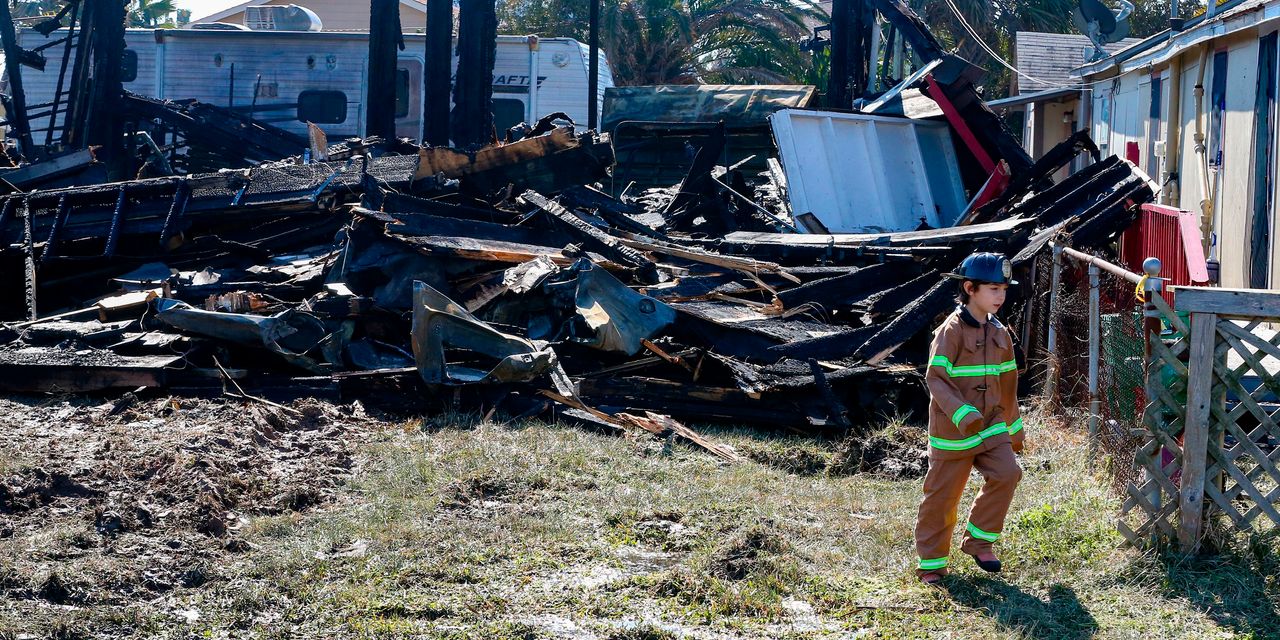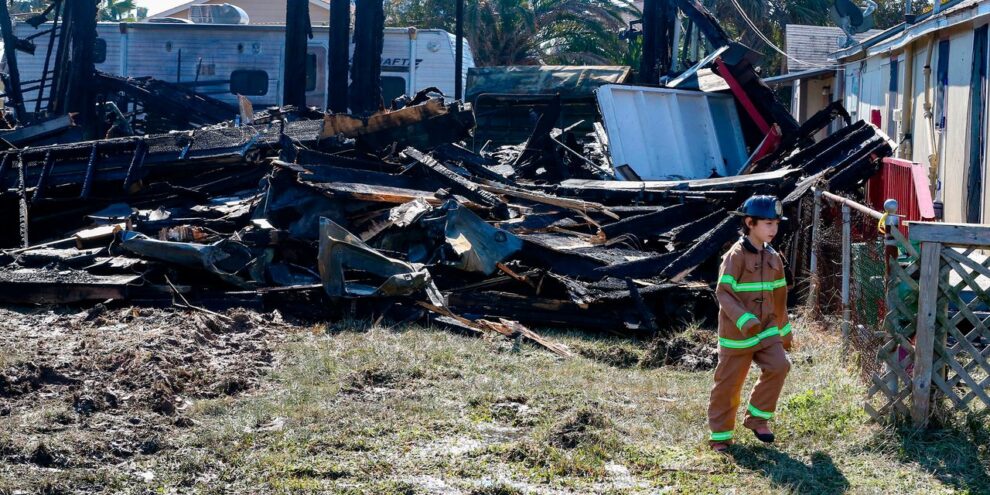
As Texans begin the slow recovery from a debilitating winter storm, they may need every penny they can get from their insurance policies.
They’ve certainly been paying for the coverage because Lone Star residents on average pay some of the steepest homeowners and renters insurance premiums in the country, statistics show.
Homeowners’ insurance premiums in the state cost approximately $1,955 annually compared to the $1,249 national average, according to Insurance Information Institute.
That’s the third-most expensive premium in the country, according to the industry-funded consumer education association’s analysis of 2018 numbers, the most recently available.
Renters’ insurance premiums cost $225 per year on average versus the $179 average, making it the fourth-most expensive renters’ insurance premium.
As of Monday, there were less than 16,405 Texas residents still without power, down from 200,000 on Friday and 4 million earlier in the week, according to the outage tracking site, Poweroutage.us. Meanwhile, millions of people were under a boil-water advisory, said NBC News.
The Insurance Council of Texas, a nonprofit, state trade association that serves property and casualty insurance carriers and their customers, warned residents of the freezing temperatures on Feb. 11, sending out advice to media outlets.
“Frozen pipes are an annual issue for many Texans and taking steps to protect your home when temperatures drop below the freezing mark is critical to prevent bursting and leaking pipes that can cause thousands of dollars in repairs,” Camille Garcia, the organization’s director of communications and public affairs, said in a statement.
The good news
The good news: Many homeowners and renters insurance policies should cover the winter weather-related havoc, according to insurance experts.
Water damage from a burst pipe would likely be in a homeowners policy while renters insurance would reimburse a policyholder up to a coverage limit if that same burst pipe, for example, ruined a renter’s furniture, clothes and computer.
Of course, you must to have the insurance policy first.
About 95% of homeowners across the country have homeowners insurance policies, said Insurance Information Institute spokeswoman Loretta Worters. That’s because mortgage lenders will require the coverage, she said.
Renters insurance is a different story. Only 41% of renters nationwide had renters insurance in 2018, according to Worters.
“Cost is one factor,” said Robert Hunter, director of insurance at the Consumer Federation of America. Someone who is renting might have tight finances, especially during the pandemic, he noted. “But I think also, people don’t think they need it.”
As the storm hit the state earlier this month, the Insurance Council of Texas said that homeowner policies provide differing levels of coverage for water damage, and advised residents to discuss coverage, know their deductible and ensure they’re adequately covered.
Why are Texas premiums high?
Premiums vary among states, depending on factors like the housing inventory and weather hazards within a particular state, said Worters. The recent winter storm — which put Texas’ power grid in “seconds and minutes” away from a complete failure — foretells more extreme weather to come with climate change, some energy analysts said.
The take-up rates on homeowners and renters insurance in Texas mirror the national averages, according to Camille Garcia, director of communications and public affairs at the Insurance Council of Texas, a trade association.
“ Compounding this natural disaster is a manmade disaster.’ ”
The premium prices are largely influenced by local weather, she said. “Every single year, we face hurricanes, tornados, hail storms, wild fires, dust storms. It’s just one of these states where we have natural disasters we face continually. Because of that, our product is priced to the risk,” she said.
While other Texas weather can pummel one part of the state — like Hurricane Harvey’s catastrophic 2017 lash of the Gulf Coast — this storm slammed the entire state, she said. “The sheer number of claims are extraordinary” and there could be “hundreds of thousands” of claims. Those claims include fender benders and houses and businesses that are completely damaged by burst pipes, she said.
Hurricane Harvey resulted in a total insured loss of $30 billion, which would now be almost $31.6 billion adjusted for inflation, according to the Insurance Information Institute.
“Document everything,” Garcia urged. That means taking pictures and videos of damage, even documenting when conversations occurred with adjusters, insurers and others in the claims process.
The weather is certainly a factor in the premium prices, Hunter said — “that and the lack of good regulators.”
“ ‘Document everything.’ ”
Hunter, who served as Texas’ insurance commissioner from 1993 to 1995, said the state’s “regulatory situation has turned laissez faire. We challenged rates. We held hearings on rates. That’s the kind of things we did as regulators. I don’t see much of that in Texas.”
“Texans have been asked to pay more and more for insurance coverage for policies that cover less and less,” said Ware Wendell, executive director of Texas Watch, a non-profit organization advocating for policyholders.
The Austin, Texas resident spent the first half of his Friday shoveling snow into two kiddy pools just to have some water source after three days without tap water. “This is where we are. It’s really upsetting,” Wendell said.
The insurance industry rallied to get a 2017 House Bill 1774 through the state legislature making it more difficult for policyholders to sue their insurance company after an underpayment or denial, Wendell said.
“ The Texas insurance industry in 2017 rallied to get a House Bill 1774 through the state legislature. ”
The bill is known pejoratively as the Blue Tarp Law, named because critics said residents will have to make do with blue tarp on their homes to cover up damage.
When a policyholder sues an insurance carrier after a storm, the lawsuit’s initial money demand needs to be within 20% of the final jury award. If that doesn’t happen, plaintiffs’ legal fees are paid out of the award to them versus a separate award for legal fees, Wendell said.
“You and your attorney have to have a crystal ball at the beginning of the process. You have to hire you own experts and project what will jury do,” he said. That could deter insurance lawsuits altogether, he added. The law also reduced penalties when insurers dragged out the claims process, Wendell noted.
At the time, the Insurance Council of Texas vigorously defended the House Bill 1774, and said it “protects consumers’ right to sue for weather-related claims while making changes to prevent abusive litigation practices.
“The bill helps to stop abusive practices and lawsuits that were threatening both the affordability and availability of property insurance in Texas,” it added.
“The genesis of HB 1774 began in 2012, after a major hailstorm in Hidalgo County, when some trial lawyers and others began taking advantage of existing law to file unnecessary and abusive lawsuits by making excessive claims demands and filing lawsuits. This abusive litigation model then spread to other parts of Texas after hailstorms,” it said.
“Lawyers and others solicited cases through advertising, going door to door, setting up outside grocery stores and at flea markets, and in some examples filed lawsuits even when the homeowner did not know that one had been filed on their behalf,” it added.
Is there a ‘rude awakening’ coming?
And now? Texans are confronting steep prices in the wake of the storm, like bottled water sold at triple the price and $1,000-a-night hotel rooms. The insanely high prices have judges and the Texas Attorney General warning against price gouging.
Still more financial pain could come between the lack of coverage and underpayments, consumer advocates say.
As the pandemic tore into the economy last year, it’s possible many people who had renters insurance ended the coverage to conserve costs, Hunter said. They might not have anticipated a devastating winter storm back in spring 2020.
This is “the last thing” that anyone would need if they were already in tight times, Hunter added. “I would say more than half of the people with damage are going to have to eat it,” Hunter said.
Wendell worries about the people who have coverage but still might end up with a denial, a partial payout and then an uphill battle inside the courthouse.
“Compounding this natural disaster is a manmade disaster,” he said, point to the 2017 law related to insurance lawsuits. “Texas policyholders are in for a rude awakening in the weeks and months ahead.”






